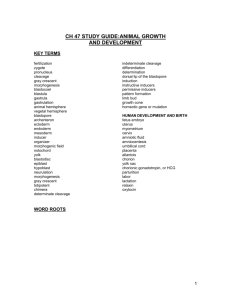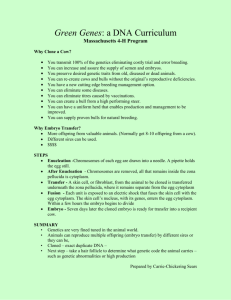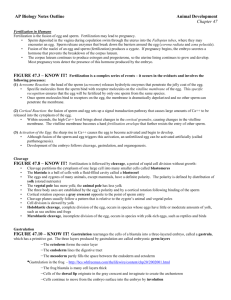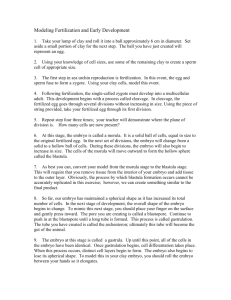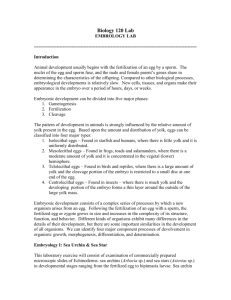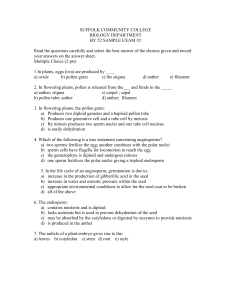Introduction - Cedar Crest College
advertisement
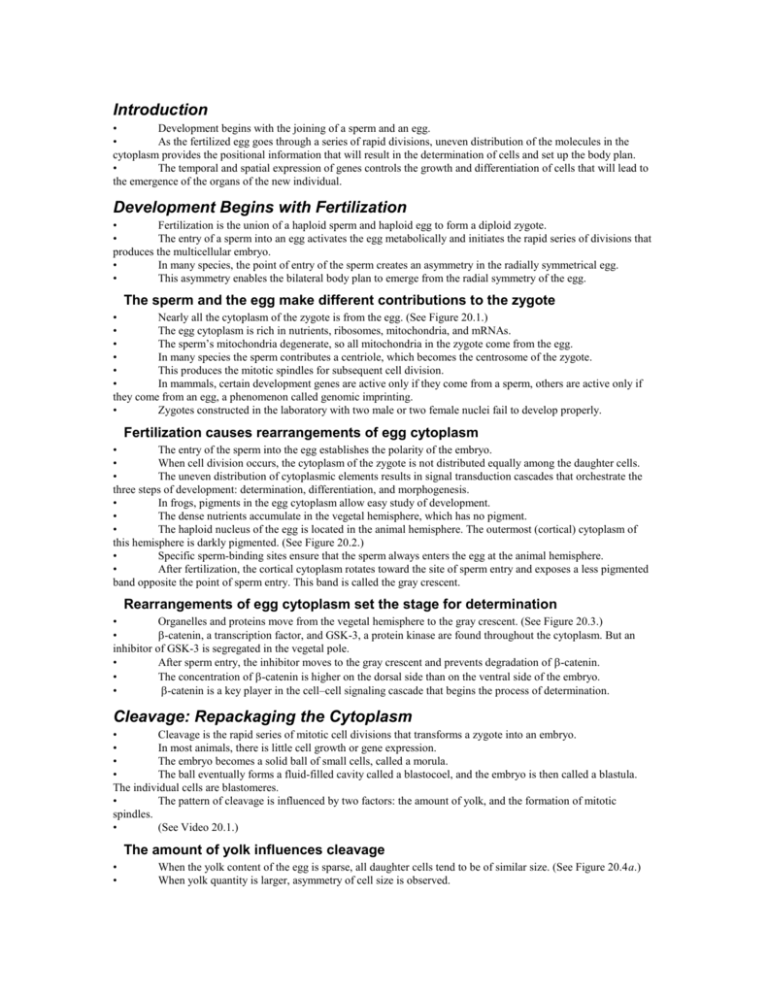
Introduction • Development begins with the joining of a sperm and an egg. • As the fertilized egg goes through a series of rapid divisions, uneven distribution of the molecules in the cytoplasm provides the positional information that will result in the determination of cells and set up the body plan. • The temporal and spatial expression of genes controls the growth and differentiation of cells that will lead to the emergence of the organs of the new individual. Development Begins with Fertilization • Fertilization is the union of a haploid sperm and haploid egg to form a diploid zygote. • The entry of a sperm into an egg activates the egg metabolically and initiates the rapid series of divisions that produces the multicellular embryo. • In many species, the point of entry of the sperm creates an asymmetry in the radially symmetrical egg. • This asymmetry enables the bilateral body plan to emerge from the radial symmetry of the egg. The sperm and the egg make different contributions to the zygote • Nearly all the cytoplasm of the zygote is from the egg. (See Figure 20.1.) • The egg cytoplasm is rich in nutrients, ribosomes, mitochondria, and mRNAs. • The sperm’s mitochondria degenerate, so all mitochondria in the zygote come from the egg. • In many species the sperm contributes a centriole, which becomes the centrosome of the zygote. • This produces the mitotic spindles for subsequent cell division. • In mammals, certain development genes are active only if they come from a sperm, others are active only if they come from an egg, a phenomenon called genomic imprinting. • Zygotes constructed in the laboratory with two male or two female nuclei fail to develop properly. Fertilization causes rearrangements of egg cytoplasm • The entry of the sperm into the egg establishes the polarity of the embryo. • When cell division occurs, the cytoplasm of the zygote is not distributed equally among the daughter cells. • The uneven distribution of cytoplasmic elements results in signal transduction cascades that orchestrate the three steps of development: determination, differentiation, and morphogenesis. • In frogs, pigments in the egg cytoplasm allow easy study of development. • The dense nutrients accumulate in the vegetal hemisphere, which has no pigment. • The haploid nucleus of the egg is located in the animal hemisphere. The outermost (cortical) cytoplasm of this hemisphere is darkly pigmented. (See Figure 20.2.) • Specific sperm-binding sites ensure that the sperm always enters the egg at the animal hemisphere. • After fertilization, the cortical cytoplasm rotates toward the site of sperm entry and exposes a less pigmented band opposite the point of sperm entry. This band is called the gray crescent. Rearrangements of egg cytoplasm set the stage for determination • Organelles and proteins move from the vegetal hemisphere to the gray crescent. (See Figure 20.3.) • -catenin, a transcription factor, and GSK-3, a protein kinase are found throughout the cytoplasm. But an inhibitor of GSK-3 is segregated in the vegetal pole. • After sperm entry, the inhibitor moves to the gray crescent and prevents degradation of -catenin. • The concentration of -catenin is higher on the dorsal side than on the ventral side of the embryo. • -catenin is a key player in the cell–cell signaling cascade that begins the process of determination. Cleavage: Repackaging the Cytoplasm • Cleavage is the rapid series of mitotic cell divisions that transforms a zygote into an embryo. • In most animals, there is little cell growth or gene expression. • The embryo becomes a solid ball of small cells, called a morula. • The ball eventually forms a fluid-filled cavity called a blastocoel, and the embryo is then called a blastula. The individual cells are blastomeres. • The pattern of cleavage is influenced by two factors: the amount of yolk, and the formation of mitotic spindles. • (See Video 20.1.) The amount of yolk influences cleavage • • When the yolk content of the egg is sparse, all daughter cells tend to be of similar size. (See Figure 20.4a.) When yolk quantity is larger, asymmetry of cell size is observed. • The frog egg’s vegetal hemisphere ends up with fewer but larger cells than the animal pole. (See Figure 20.4b.) • Both sea urchins and frogs produce embryos with complete furrows. • Eggs that contain a large amount of yolk, such as chicken eggs, provide greater resistance to cleavage furrow formation. • The embryo develops as a blastodisc on the surface of the yolk mass. (See Figure 20.4c.) • This type of incomplete cleavage is called discoidal cleavage. • Incomplete cleavage is common in some fishes, all reptiles, and all birds. • Drosophila (fruit flies) undergo superficial cleavage. (See Figure 20.4d.) • Mitosis occurs without cytokinesis to produce an embryo with many nuclei in a common cytoplasm. • Later, the nuclei migrate and the plasma membrane of the egg folds in to compartmentalize the nuclei in cells around the periphery. The orientation of mitotic spindles influences the pattern of cleavage • Mitotic spindles determine the cleavage planes and daughter cell arrangements. • If the mitotic spindles of successive cell divisions form at right angles or parallel to the animal–vegetal axis, a radial cleavage pattern results. (See Figure 20.4a and 20.4b.) • This is the cleavage pattern in sea urchins and frogs. • In mollusks, the successive mitotic spindles are not at right angles. • The pattern has a twist, and is called spiral cleavage. Cleavage in mammals is unique • In mammals, the first cell division is parallel to the animal–vegetal axis and the second cell division occurs at right angles. • This pattern is referred to as rotational cleavage and is unique to mammals. (See Figure 20.5a.) • Cleavage in mammals is slow, with divisions occurring 12–24 hours apart. • Cell divisions in mammalian blastomeres are not synchronous, so the number of cells in the embryo does not follow the regular progression (2, 4, 8, 16, 32, etc.) typical of other species. • Unlike the process in other species, genes expression plays a role in cleavage. • Mammals have complete cleavage during the early cell division. • Tight junctions form at the 8-cell stage in embryos. (See Figure 20.5b.) • At the transition from the 16-cell to 32-cell stage, the cells separate into two masses. • The inner cell mass develops into the embryo; the outer cells become the trophoblast, which becomes part of the placenta. • The trophoblast cells secrete fluid which forms the blastocoel. The embryo is called a blastocyst. • Fertilization in mammals occurs in the upper oviduct, cleavage occurs as the zygote travels down the oviduct. • When the blastocyst arrives in the uterus, the trophoblast adheres to the uterine wall (the endometrium), which begins the process of implantation. (See Figure 20.14.) • Early implantation in the oviduct wall is prevented by the zona pellucida. • In the uterus, the blastocyst hatches out of the zona pellucida, and implantation can occur. Specific blastomeres generate specific tissues and organs • In many animals, the movement of blastomeres is so regular that it is possible to label a specific blastomere and identify the tissues and organs that develop from its progeny. (See Figure 20.6.) • This procedure can produce fate maps. • Blastomeres become determined, or committed to a specific fate at different times in different animals. • Roundworm and clam blastomeres are already determined at the 8-cell stage. • If a cell is removed, a portion of the embryo fails to develop normally. This is called mosaic development. • Sea urchins, frogs, and vertebrates have regulative development. • The loss of some cells during cleavage is tolerated and the remaining cells compensate. • In regulative development, blastomeres are capable, to a certain extent, of forming an entire embryo. • Identical twins begin as one zygote from which two separate embryos will develop. (See Figure 20.7.) Gastrulation: Producing the Body Plan • axes. • • tract. • Gastrulation is the process in which a blastula is transformed into an embryo with tissue layers and body During gastrulation, three germ layers form: The inner germ layer is the endoderm, and gives rise to the digestive tract, circulatory tract, and respiratory The outer layer, the ectoderm, gives rise to the epidermis and nervous system. • The middle layer, the mesoderm, contributes to bone, muscle, liver, heart, and blood vessels. Invagination of the vegetal pole characterizes gastrulation in the sea urchin • The sea urchin blastula is a simple, hollow ball of cells. • When gastrulation commences, the cells around the vegetal hemisphere flatten. (See Figure 20.8.) • The region invaginates into the blastocoel. • Some cells migrate away from the invaginating region and become primary mesenchyme cells. • The invagination becomes the primitive gut or archenteron, and the mesenchyme cells become mesododerm. • Secondary mesenchyme cells break free from the tip of the archenteron. • The region where the archenteron contacts the far side of the sphere becomes the mouth. • The anus forms at the region around the origin of the invagination. • Mesenchymal cells form when some of the cells forming the invagination lose their attachment to neighboring cells. • Once in the cavity, they move by extending long processes called filopodia, which they use to move along an extracellular matrix of proteins that has been previously laid down by the ectodermal cells lining the blastocoel. • When the different tiers of blastula cells are separated, they show different developmental potentials. (See Figure 19.7.) • It has been proposed that the reason for these differences is an uneven distribution of transcriptional regulatory proteins in the egg cytoplasm. • (See Video 20.2.) Gastrulation in the frog begins at the gray crescent • Amphibian gastrulation begins when cells in the gray crescent change shape and bulge inward. These cells are called bottle cells. • These cells change their shape and their cell adhesion properties. (See Figure 20.9.) • Their main bodies bulge inward while they remain attached to the outer surface of the blastula by slender necks. • This process and the movement of surface cells generate the dorsal lip, over which a sheet of cells moves into the blastocoel. • The first involuting cells are endoderm, and form the primitive gut, the archenteron. • Some of the migrating cells become mesoderm. • The initial site of involution is the dorsal lip of the blastopore. • Cells from the animal hemisphere migrate toward the blastopore, a process called epiboly. • Gastrulation is complete when three germ layers have been established. • (See Video 20.3.) The dorsal lip of the blastopore organizes embryo formation • Spemann conducted experiments in the early 1920s to study the role of the gray crescent. (See Figure 20.10.) • He constricted salamander embryos with a single human baby hair. • Bisection with a shared gray crescent produced twins, but if just one side received a gray crescent, only that side gastrulated. • The next experiments involved transplanting gastrula tissues onto other gastrulas. • In transplants in early gastrulas, the transplanted pieces developed into tissue that were appropriate for the location where they were placed. The fates of the cells had not yet been determined. • If late gastrulas were used, the fates were determined, and transplants did not develop into the same tissue. • In another experiment, the important role of the dorsal lip was demonstrated. (See Figure 20.11 and Animated Tutorials 20.1 and 20.2.) • A graft of a dorsal lip to a developing embryo created a second embryo. • Spemann referred to the dorsal lip of the blastopore as the primary embryonic organizer, or simply the organizer. • Molecular mechanisms of the organizer: • The role of -catenin in gastrulation has been verified using molecular biology technology. • When the production of -catenin is depleted by injection of antisense RNA into the egg, no gastrulation proceeds. • If -catenin is experimentally overexpressed in another region of the embryo, it can induce a second axis of embryo formation. • The protein -catenin appears to play critical roles in generating signals that induce primary embryonic organizer activity. • Figure 20.12 details the -catenin regulated pathways that are essential for activating genes in the organizer. • Molecular mechanisms of left–right axis formation: • There are a number of known genes necessary for normal left–right organization of the body. • If one of these genes is knocked out, it can randomize the left–right organization of the internal organs. • The complete details of this mechanism are not fully understood. • It appears that a left–right differential distribution of some of the of some of the transcription factors triggers a mechanism that acts very early during gastrulation. Reptilian and avian gastrulation is an adaptation to yolky eggs • Birds and reptiles have modified gastrulation to adapt to huge yolk sizes. (See Figure 20.13.) • Cleavage forms a blastodisc composed of an epiblast, which will form the embryo, and a hypoblast, which gives rise to the extraembryonic membranes. • The blastocoel is the fluid-filled space between the epiblast and the hypoblast. • Gastrulation begins when cells move toward the midline of the epiblast, forming a ridge called the primitive streak. • A primitive groove forms along the primitive streak. • The primitive groove becomes the blastopore. Cells migrate through it and become endoderm and mesoderm. • At the forward region of the groove is Hensen’s node, which is equivalent to the dorsal lip of the amphibian blastopore. • Cells that pass over Hensen’s node become determined by the time they reach their destination. Mammals have no yolk, but retain the avian–reptilian gastrulation pattern • Mammals begin with complete cleavage, but then follow the developmental pattern of birds, forming an embryonic disc. (See Figure 20.14.) • The inner cell mass of the blastocyst splits into an epiblast and hypoblast with a fluid-filled cavity in between. • The embryo develops from the epiblast, the hypoblast forms the extraembryonic membranes. • The epiblast also splits off a layer of cells that form the amnion. The amnion grows around the developing embryo. • Gastrulation is similar to birds, a primitive groove forms and cells migrate through it to become endoderm and mesoderm. Neurulation: Initiating the Nervous System • • • Gastrulation produces an embryo with three germ layers. Organogenesis occurs next and involves the formation of organs and organ systems. Neurulation occurs early in organogenesis and begins the formation of the nervous system. The stage is set by the dorsal lip of the blastopore • Figure 20.15 shows neurulation in the frog embryo. • The first cells to pass over the dorsal lip become the endodermal lining of the digestive tract. • The second group of cells become mesoderm. The dorsal mesoderm closest to the midline (chordomesoderm) becomes the notochord. • The notochord is connective tissue and is eventually replaced by the vetebral column. • The chordomesoderm induces the overlying ectoderm to begin forming the nervous system. • Neurulation begins with thickening of the ectoderm above the notochord to form the neural plate. • Edges of the neural plate thicken to form ridges. Between the ridges a groove forms and deepens. • The ridges fuse, forming a cylinder—the neural tube. • The anterior end of the neural tube becomes the brain. • Failure of the neural tube to close completely at the posterior end results in spina bifida; at the anterior end it results in anencephaly, in which the forebrain does not develop. • Neural tube defects are found in 1 in 300 births. • This number could be cut in half if pregnant women received adequate folic acid (a B vitamin). • (See Video 20.3.) Body segmentation develops during neurulation • Figure 20.16 shows the development of body segmentation. • Blocks of mesoderm called somites form on both sides of the neural tube. • Somites produce cells that form the vertebrae, ribs, and muscles of the trunk and limbs. • They help guide the organization of the peripheral nerves. • When the neural tube closes, cells called neural crest cells break loose and migrate inward between the epidermis and the somites and under the somites. • The neural crest cells give rise to many structures, including peripheral nerves, which connect to the spinal cord. • As development progresses, the body segments differentiate. Hox genes control development along the anterior–posterior axis • Anterior–posterior location information uses several different sets of developmental genes, including homeotic genes. • Four families of genes, called homeobox or Hox genes, control differentiation along the body axis in mice. • Each family consists of 10 genes and resides on a different chromosome. • Temporal and spatial expression of these genes follows the same pattern as their linear order on their chromosomes. (See Figure 20.17.) • Hox genes give cells positional information on their anterior–posterior body axis location. • Other genes give dorsal–ventral position information. • Sonic hedgehog is an example of a dorsal–ventral gene that is produced by the notochord and induces cells in the overlying neural tube. • Another family of homeobox genes, the Pax genes, are important in nervous system and somite development. • Pax3 is expressed in neural tube cells that will become dorsal spinal cord cells. • Pax3 and sonic hedgehog interact to determine dorsal–ventral differentiation of the spinal cord. Extraembryonic Membranes • Embryos of reptiles, birds, and mammals are surrounded by several extraembryonic membranes. Extraembryonic membranes form with contributions from all germ layers • The yolk sac is an extraembryonic membrane in chick embryos. • The yolk sac extends from the endodermal tissue of the embryonic disc (hypoblast). (See Figure 20.18.) • It constricts at the top to create a tube. • Yolk is digested by the endodermal cells of the yolk sac, and the nutrients are transported through blood vessels lining the outer surface of the yolk sac. • The allantoic membrane, an outgrowth of the extraembryonic ectoderm, forms the allantois, a sac for storage of metabolic wastes. • Ectoderm and mesoderm combine and extend beyond the embryo to form the amnion and the chorion. • The amnion surrounds the embryo, forming a cavity. It secretes fluid into the cavity that provides protection for the embryo. • The chorion forms a continuous membrane just under the eggshell. It limits water loss, and functions in gas exchange. Extraembryonic membranes in mammals form the placenta • In mammals, the first extraembryonic membrane to form is the trophoblast. • After hatching from the zona pellucida, a mammalian embryo burrows into the endometrium • This process is called implantation. • Adhesion molecules attach to the uterine wall and proteolytic enzymes disrupt the uterine cells. • The trophoblastic cells then send out numerous projections, or villi, to increase the surface area in contact with maternal blood. • The hypoblast cells extend to form a yolk sac, but there is no yolk. • The yolk sac contributes mesodermal tissues that interact with trophoblast tissues to form the chorion. • The chorion, along with the tissues of the uterine wall, produces the placenta. (See Figure 20.19.) • The amnion becomes an encapsulating structure filled with fluid, in which the embryo floats. • Allantoic tissues contribute to the formation of the umbilical cord, by which the embryo is connected to the chorionic placenta. (See Figure 20.19.) The extraembryonic membranes provide means of detecting genetic diseases • • • • Amniocentesis is used to detect defects in embryos. Down syndrome, cystic fibrosis, and Tay Sachs disease can be detected using this technique. It involves drawing a sample from the amniotic fluid and assaying the retrieved cells. A newer technique is chorionic villus sampling which makes earlier detection possible. (See Figure 20.20.) Human Development • • • • Gestation in humans lasts about 266 days. In horses, it lasts 330 days. In mice, it is just 21 days long. The events of human gestation are divided into three trimesters. Intrauterine development can be divided into three trimesters • The first trimester: • The first trimester in humans begins with fertilization. • Implantation takes place 6 days later. • The heart first beats at 4 weeks. • Limbs form at 8 weeks. (See Figure 20.21a.) • The embryo is particularly vulnerable to radiation, drugs, and chemicals during the first trimester. • Hormonal changes can cause major responses in the mother, including morning sickness, mood swings, changes in the senses of taste and smell, and swelling of the breasts. • The second trimester: • During the second trimester the fetus grows rapidly to about 600g. • Fingers, toes, and facial features become well formed. • Fetal movements are first felt by the mother early in the second trimester. • By the end of the second trimester, the fetus may suck its thumb. (See Figure 20.21b.) • The third trimester: • The fetus and the mother continue to grow during the third trimester. • Throughout the third trimester, the fetus remains susceptible to environmental factors such as malnutrition, alcohol consumption, and cigarette smoking. • Kidneys produce urine, the liver stores glycogen, and the brain undergoes cycles of sleep and waking. • (See Video 20.4.) Developmental changes continue throughout life • Humans undergo enormous developmental changes in the brain in the years between birth and adolescence. • The organization of the nervous system exhibits a great deal of plasticity in the early years, as patterns of connections between neurons develop. • For example, a child born with its eyes misaligned will use mostly one eye. • The connections to the brain from this eye will become stronger, while the connections to the other eye will become weak. • If eye alignment is corrected in the first three years of life, these connections can correct themselves. • If the condition is corrected after three years, the correct connections will not develop. • A current area of research into this developmental plasticity in the nervous system examines the role of learning in stimulating the production and differentiation of new neurons in the brain. • (See Videos 20.5–20.8.)

